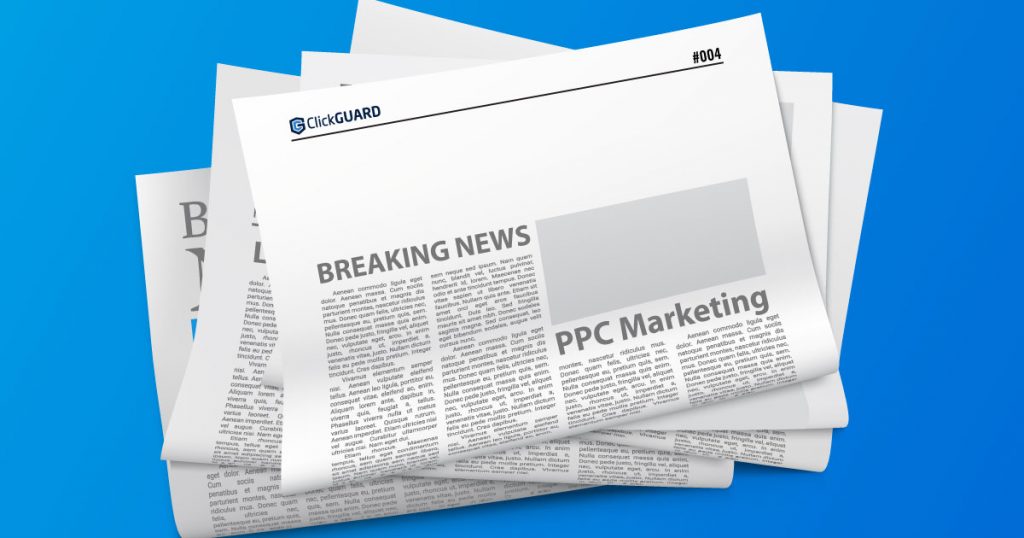Click-through-rate (CTR) is a key metric that you must keep an eye on when running a PPC campaign on any type of ad network (like Google or Bing). In fact, CTR isn’t just limited to online ads, as it is used in all types of marketing campaigns, ranging from email marketing to content marketing, social media marketing, influencer marketing, and beyond.
It makes sense that CTR is such an important metric, right? When you are paying for clicks (as in PPC campaigns), you need to be extra cautious of the CTR as it is linked to conversion rate, quality score, CPC, and several other variables.
Want to learn more about this essential metric in marketing?
This guide covers everything about CTR starting from what is CTR, its importance and benefits, what is a good CTR, how to improve CTR, and more.
What is CTR?
CTR here, CTR there, CTR everywhere (no, we’re not doing a dance here).
But WHAT is CTR, more specifically?
In short, CTR is defined as the number of clicks your ad receives in comparison to the number of people who see your ad.
The formula to calculate CTR is:
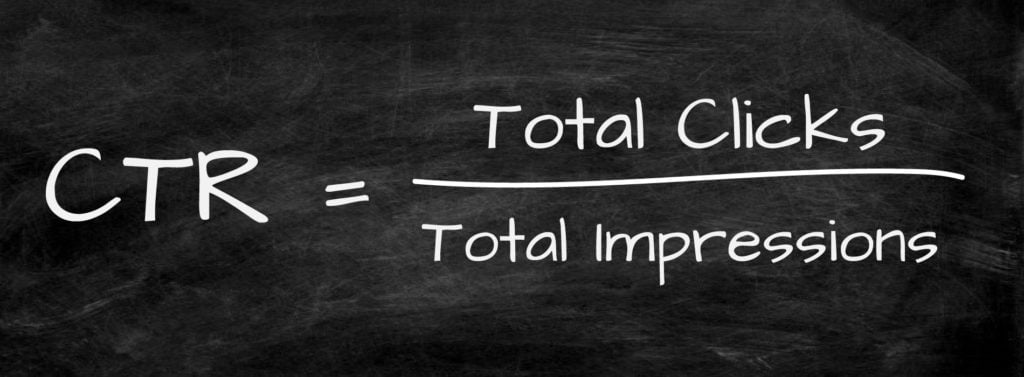
Keep in mind that CTR is measured in percentage points, so you’ll have to convert the actual number into a percentage. If your ad was seen by 100 people and 10 people clicked the ad, here is how you’ll calculate the CTR:
CTR = 10 / 100 = 0.1
Converting 0.1 into a percentage, we get:
CTR = 0.1 = 10%
This means your CTR is 10% which implies that on average, 10% of people will click your ad while the other 90% won’t click the ad. You can use this a measure of how relevant your ad is to searcher query or simply your ad’s relevance.
If your ad is relevant to what a potential buyer is looking for, he/she will be more likely to click it. Consider the following example:
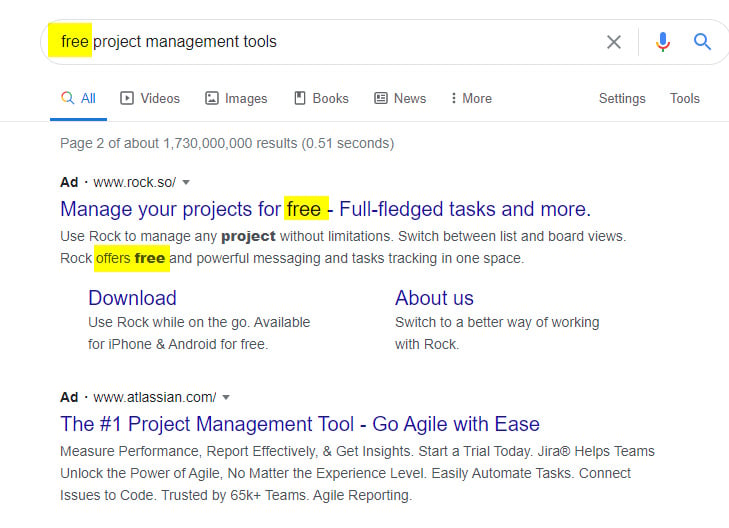
If you are looking for a free project management tool, you’ll be most likely to click an ad that explicitly mentions the word “free” in the ad copy as opposed to an ad that doesn’t mention it.
Why?
Because, if you are looking for a free project management tool, an ad that says “free” is more relevant. Kinda obvious, right?
This is how your ad drives clicks. A well-written ad, placed correctly, in front of the right eyes will naturally have a high CTR.
Why CTR is Important
Now that you know what is CTR, let’s talk about why it is important for your PPC campaign. Your click-through-rate is very important in any advertising campaign you might run. A high CTR means your ad is generating traffic and this is the first step in the conversion process. Beyond that, your CTR goes beyond simple clicks:
1. A Metric to Adjust Your PPC Campaigns
You run an ad campaign to generate traffic and buys, right? This means that your CTR helps you measure if your ads are being clicked and you are getting traffic.
But what’s probably even more important is that your CTR helps you compare keywords, ads, ad groups, location, devices, demographics, and other important bits of data you can use in creating future campaigns.. For example, using this information, you can identify low CTR keywords or zip codes and exclude them.
Similarly, you can identify high CTR keywords and increase their bid to drive more traffic. The CTR is a basic performance measure anyone can track easily. Even if you don’t know what is CTR and how to calculate it, you can still make sense of it by simply looking at the report generated by your ad network.
The simplicity of the CTR metric makes it one of the first ones you should look at when monitoring the performance of your ads.
2. Measures High Conversion Rate
A campaign’slick-through-rate is tightly connected to conversions. More clicks on your ad means that more people are visiting your landing page. Thus, conversion chances are higher.
For example, if you have a CTR of 5% with an average conversion rate of 2% for a specific landing page, sending more traffic to this page means you’ll have more conversions.
This means you can have more conversions with the same conversion rate if you increase your traffic. In other words, increasing your CTR will lead to more conversions. This is what makes CTR such a crucial metric in conversions and sales.
3. Improves Your Google Ad Quality Score
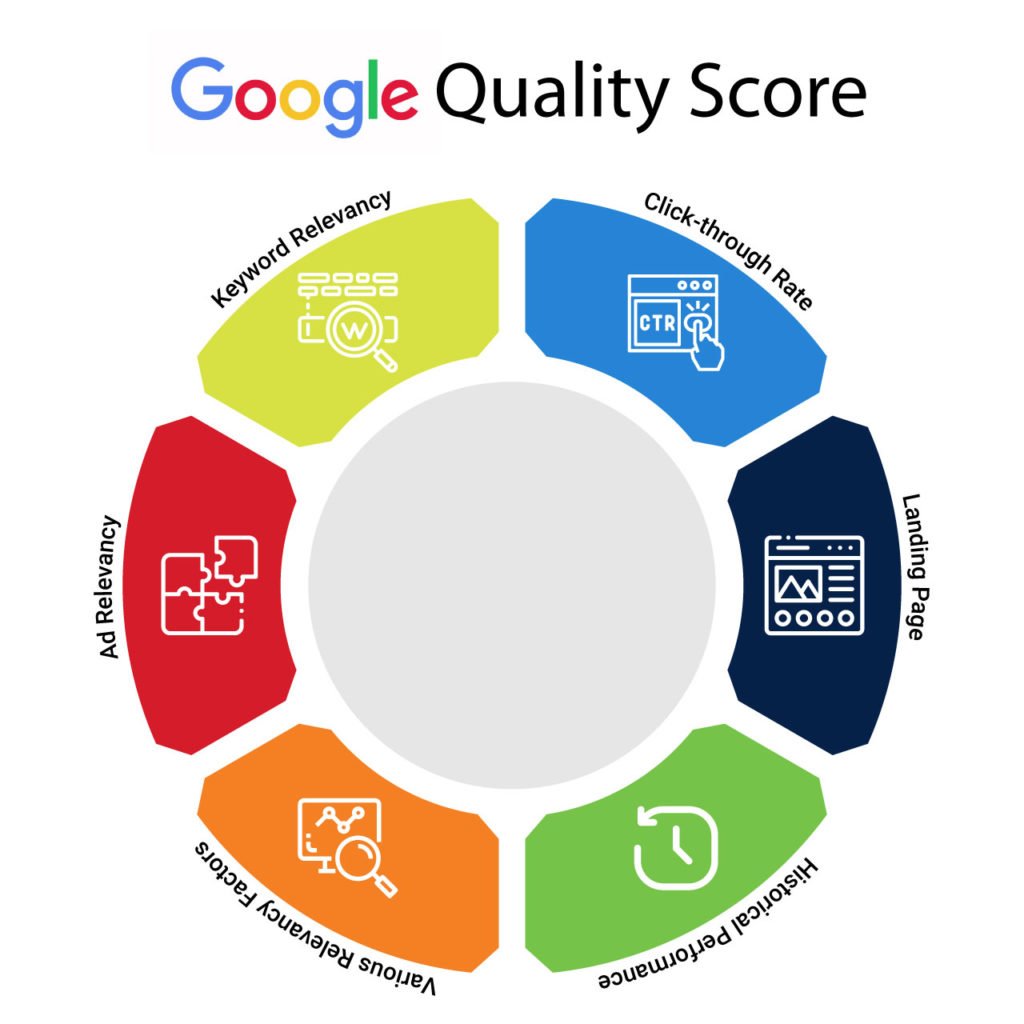
Your Google quality score is one of the key metrics you should focus on when running a Google Ads campaign. A higher quality score reduces your cost and helps you achieve a better ad position. The three key quality score variables include:
- CTR
- Ad relevance
- Landing page experience.
A high CTR means your ad is relevant to the keyword leading to a better quality score. On the other hand, low CTR means people don’t find your ad relevant to their search query and aren’t clicking your ad. This reduces your ad quality score and makes your ad lose position.
A high CTR helps you improve quality score and, eventually, your ad rank.
What is a Good CTR?
One of the most common questions that advertisers ask is: What is a good CTR?
The simple answer is: It depends.
CTR varies from ad to ad and industry to industry. Two ads promoting the same offer might have a different CTR. You never know what might work for your audience.
However, if you want to get an idea of the average CTR for Google search and display ads across leading industries, check out the following graph:
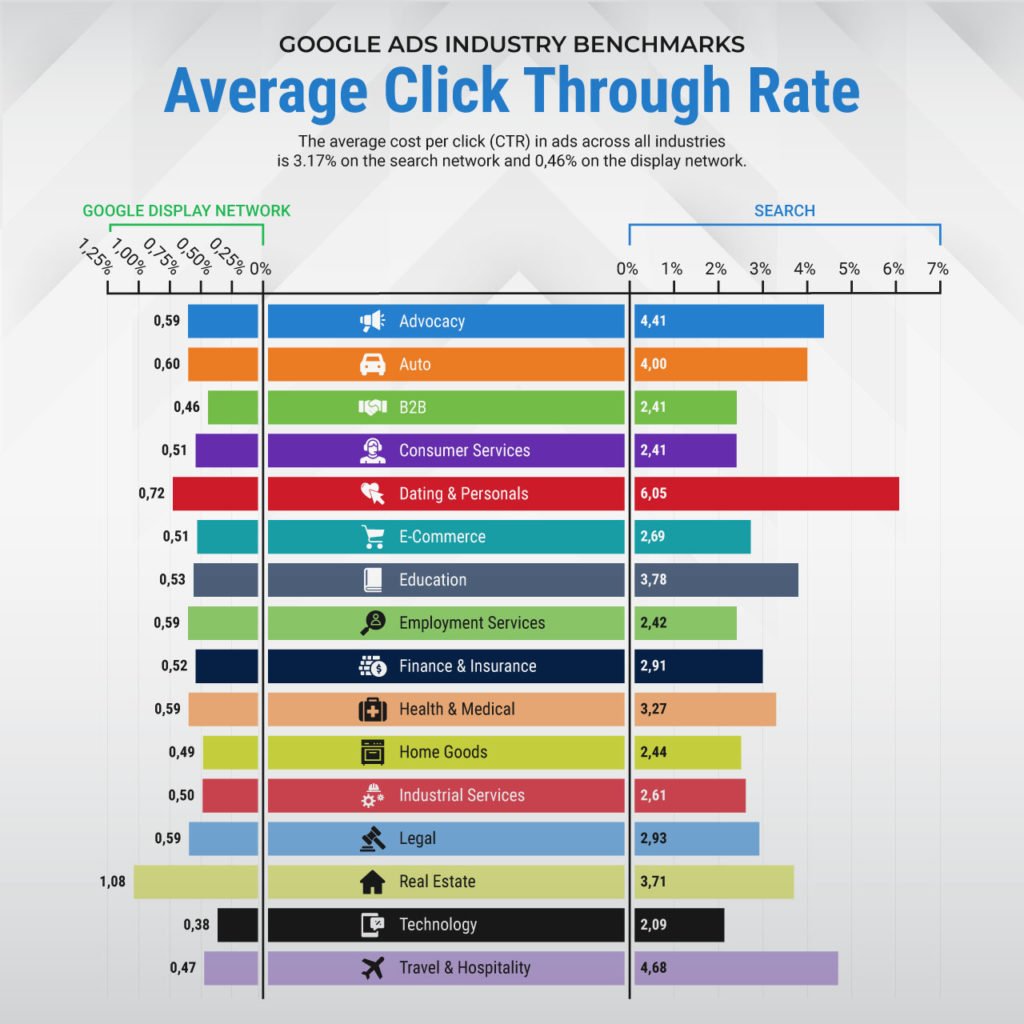
In 2020, the average Google search CTR for all the industries was 3.17% and the average display network CTR,was 0.46%. This gives you an idea of the average CTRs and, depending on your industry, you might have high or low CTR. For example, the Dating and Personals industry has a 6.05% CTR for Google search. So, if you are in the dating industry, you need to aim for CTR above 5%.
Here is another CTR benchmark report:
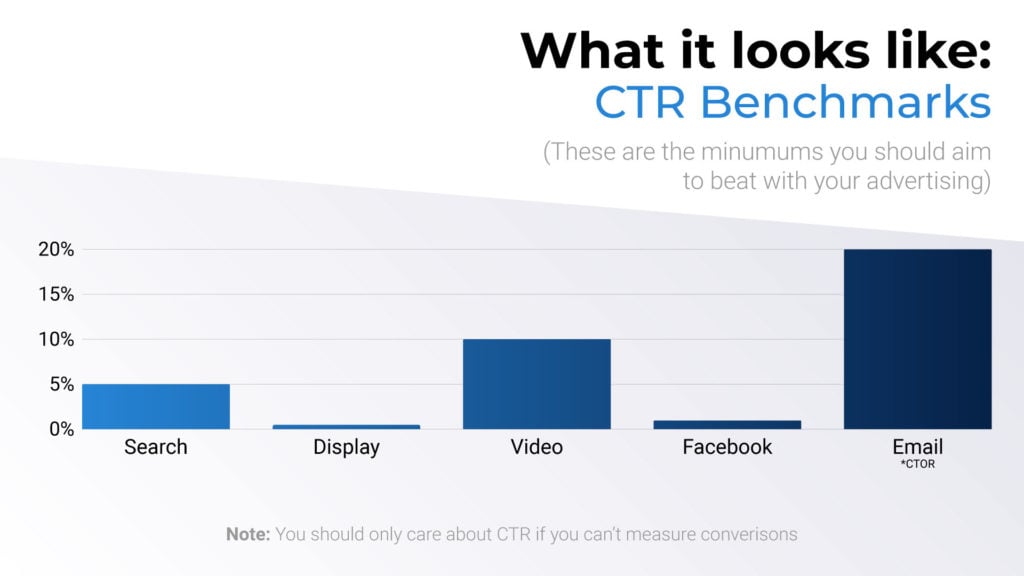
When you have an idea of the average CTRs for your industry, it gets easier to compare your CTR and see how good your campaigns are doing. Of course, when it comes to CTR, the higher it is, the better.
Of course, you shouldn’t rely solely on industry benchmark reports for CTR, as this metric can vary, according to several factors (so much so that it can be impossible to compare CTR for two different campaigns). Ultimately, the best approach is to use data to inspect how good or bad your CTR is.
For example, a high CTR with low conversions isn’t of much help, but a low CTR with high conversions can be an indicator of success. You need to monitor CTR in comparison with other metrics to make better, well-informed decisions.
Benefits of Aiming for a High CTR
Generally, aiming for a high CTR is your best bet. A high CTR has several benefits such as:
- Drives more traffic to your landing page
- Helps you achieve more conversions without spending a dime on conversion rate optimization
- Improves your quality score and ad rank
- Collecting click data that helps you better understand your target audience
- The option to run A/B tests quickly without waiting too long to see results.
A high CTR, however, isn’t always good. For example, a high CTR with low conversions means you are paying for the clicks, but you aren’t converting visitors into customers and this will ruin your ROAS. In this case, a high click-through-rate means you are paying for a lot of clicks and, if you haven’t optimized your landing page and sales funnel for conversions, you’ll regret spending money on clicks.
It makes sense to spend on clicks when you know you can convert a decent number of these visitors. Otherwise, it will only cost you money without any return.
Essential Tips to Increasing Your CTR
Understanding what is CTR isn’t enough, you must know how to improve CTR and how to achieve a high CTR for your ad campaigns. Increasing CTR isn’t too much of a task if you know what you have to do and how you have to do it.
The following tips and techniques will help you maximize CTR for any ad campaign:
- Use the main keyword in the headline to make your ad more relevant to user intent..
- One of the best ways to increase CTR is to increase your bid. Doing this will improve your ad rank and impressions. More impressions mean more clicks.
- Improve your ad copy. Make your headline catchy and keep the description concise. For display ads, use an appropriate, enticing, and engaging image.
- Use a call to action in the ad. This is a must. You have to tell the readers what they’re supposed to do once they have seen your ad.
- Use Google ad extensions such as site links, call, review, price, etc. These extensions make your search ads prominent. A prominent ad grabs user attention and it gets more clicks, as compared to other ads that aren’t using any extensions. Also, extensions provide additional information to your target audience (e.g. phone number, price, etc.), and this improves CTR.
- Improve keyword targeting. Group keywords based on their mutual relevance. You need to make sure that your ads are only triggered for the most relevant keywords. When ads are relevant to the keyword, they are more likely to have a high CTR.
- Create urgency in your ads by using countdown timers, mentioning limited stock, etc. Urgency doesn’t just drive clicks but it generates sales too, precisely because it taps into your potential buyers’ “fear of missing out”
- Use power words in your ad copy. A power word evokes emotion in your target audience and persuades them to take action. Some of the best power words to increase your CTR include:
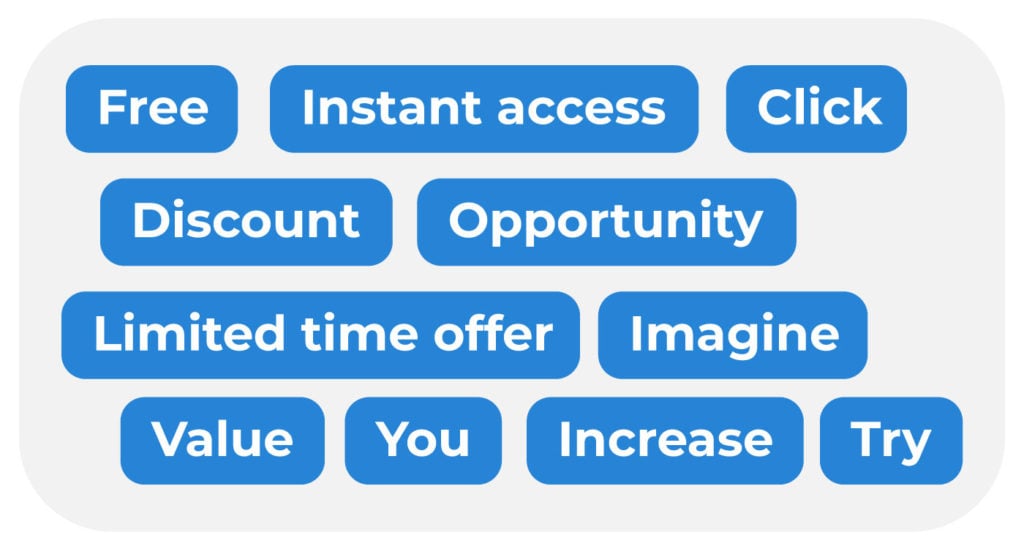
- Add your primary keyword in the URL for search ads. All the keywords in your ad copy and URL that match the searcher’s keyword are highlighted by Google.
- Use symbols, numbers, and special characters in ad copy, as this helps you grab attention. For example, using $ in the headline will instantly grab attention. This is a nice hack to a high CTR.
What Is CTR – The Bottom Line
Obviously, CTR is a much more complex issue, but hopefully, questions like What is CTR and How to get a high CTR shouldn’t be much of an issue for you by the end of this article.
CTR alone can provide you with a lot of insight into what types of ads get clicks, what types of offers work, what keywords lead to a high conversion rate, and more. While getting to a high CTR might not be an exact science, it can sure be something you can control to a large extent.
At the end of the day, it all comes down to data, testing, and tweaking your ads to figure out what your target audience likes to click on. Don’t be afraid to test different variations of ads with different keyword combinations.
Eventually, you will boost your CTR.

